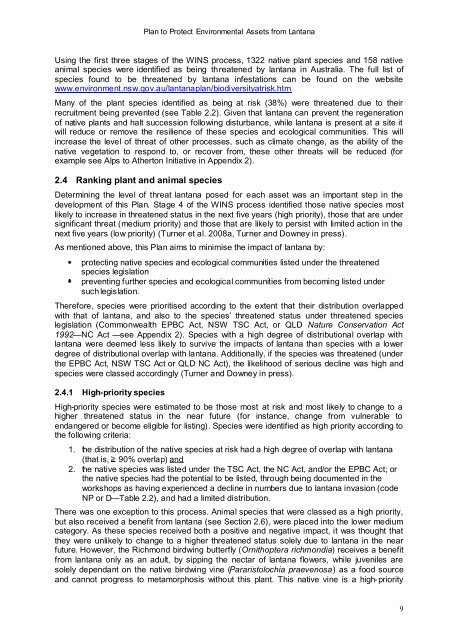Plan to Protect Environmental Assets from Lantana - Weeds Australia
Plan to Protect Environmental Assets from Lantana - Weeds Australia
Plan to Protect Environmental Assets from Lantana - Weeds Australia
Create successful ePaper yourself
Turn your PDF publications into a flip-book with our unique Google optimized e-Paper software.
<strong>Plan</strong> <strong>to</strong> <strong>Protect</strong> <strong>Environmental</strong> <strong>Assets</strong> <strong>from</strong> <strong>Lantana</strong><br />
Using the first three stages of the WINS process, 1322 native plant species and 158 native<br />
animal species were identified as being threatened by lantana in <strong>Australia</strong>. The full list of<br />
species found <strong>to</strong> be threatened by lantana infestations can be found on the website<br />
www.environment.nsw.gov.au/lantanaplan/biodiversityatrisk.htm<br />
Many of the plant species identified as being at risk (38%) were threatened due <strong>to</strong> their<br />
recruitment being prevented (see Table 2.2). Given that lantana can prevent the regeneration<br />
of native plants and halt succession following disturbance, while lantana is present at a site it<br />
will reduce or remove the resilience of these species and ecological communities. This will<br />
increase the level of threat of other processes, such as climate change, as the ability of the<br />
native vegetation <strong>to</strong> respond <strong>to</strong>, or recover <strong>from</strong>, these other threats will be reduced (for<br />
example see Alps <strong>to</strong> Ather<strong>to</strong>n Initiative in Appendix 2).<br />
2.4 Ranking plant and animal species<br />
Determining the level of threat lantana posed for each asset was an important step in the<br />
development of this <strong>Plan</strong>. Stage 4 of the WINS process identified those native species most<br />
likely <strong>to</strong> increase in threatened status in the next five years (high priority), those that are under<br />
significant threat (medium priority) and those that are likely <strong>to</strong> persist with limited action in the<br />
next five years (low priority) (Turner et al. 2008a, Turner and Downey in press).<br />
As mentioned above, this <strong>Plan</strong> aims <strong>to</strong> minimise the impact of lantana by:<br />
protecting native species and ecological communities listed under the threatened<br />
species legislation<br />
preventing further species and ecological communities <strong>from</strong> becoming listed under<br />
such legislation.<br />
Therefore, species were prioritised according <strong>to</strong> the extent that their distribution overlapped<br />
with that of lantana, and also <strong>to</strong> the species’ threatened status under threatened species<br />
legislation (Commonwealth EPBC Act, NSW TSC Act, or QLD Nature Conservation Act<br />
1992—NC Act —see Appendix 2). Species with a high degree of distributional overlap with<br />
lantana were deemed less likely <strong>to</strong> survive the impacts of lantana than species with a lower<br />
degree of distributional overlap with lantana. Additionally, if the species was threatened (under<br />
the EPBC Act, NSW TSC Act or QLD NC Act), the likelihood of serious decline was high and<br />
species were classed accordingly (Turner and Downey in press).<br />
2.4.1 High-priority species<br />
High-priority species were estimated <strong>to</strong> be those most at risk and most likely <strong>to</strong> change <strong>to</strong> a<br />
higher threatened status in the near future (for instance, change <strong>from</strong> vulnerable <strong>to</strong><br />
endangered or become eligible for listing). Species were identified as high priority according <strong>to</strong><br />
the following criteria:<br />
1. the distribution of the native species at risk had a high degree of overlap with lantana<br />
(that is, 90% overlap) and<br />
2. the native species was listed under the TSC Act, the NC Act, and/or the EPBC Act; or<br />
the native species had the potential <strong>to</strong> be listed, through being documented in the<br />
workshops as having experienced a decline in numbers due <strong>to</strong> lantana invasion (code<br />
NP or D—Table 2.2), and had a limited distribution.<br />
There was one exception <strong>to</strong> this process. Animal species that were classed as a high priority,<br />
but also received a benefit <strong>from</strong> lantana (see Section 2.6), were placed in<strong>to</strong> the lower medium<br />
category. As these species received both a positive and negative impact, it was thought that<br />
they were unlikely <strong>to</strong> change <strong>to</strong> a higher threatened status solely due <strong>to</strong> lantana in the near<br />
future. However, the Richmond birdwing butterfly (Ornithoptera richmondia) receives a benefit<br />
<strong>from</strong> lantana only as an adult, by sipping the nectar of lantana flowers, while juveniles are<br />
solely dependant on the native birdwing vine (Pararis<strong>to</strong>lochia praevenosa) as a food source<br />
and cannot progress <strong>to</strong> metamorphosis without this plant. This native vine is a high-priority<br />
9

















